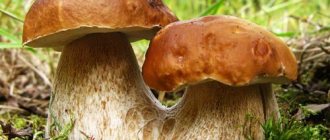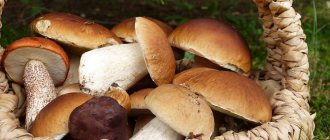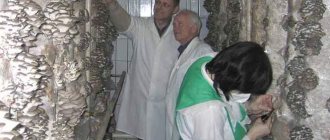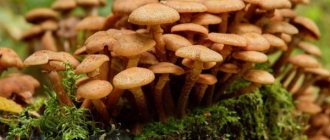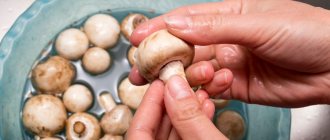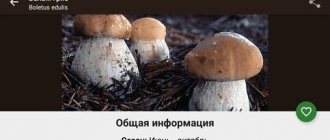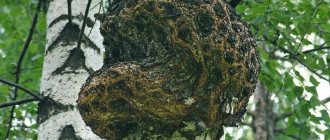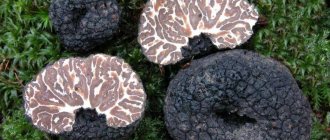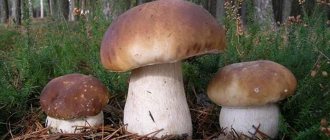At what temperature do mushrooms grow depending on the season?
Fruiting bodies of different species appear at different times. For example, in late spring you can find mossy mushrooms and boletus mushrooms in the forest, and in the fall honey mushrooms actively bear fruit.
At the same time, the mycelium hidden under a layer of humus grows and develops throughout the year. Therefore, it is not so easy to answer at what temperature mushrooms grow. To do this, let's look at each season separately.
in spring
Spring mushrooms usually appear at the end of May, when the air temperature does not drop below +18°C. Some species begin to grow at lower temperatures, however, their development will be too slow. The earliest varieties are morels and oyster mushrooms. They begin to appear above the ground as soon as the first snow melts and the temperature rises to +5°C.
In summer
In summer, the air temperature is most favorable for mushroom growth. But they can be hampered by the lack of rain and the scorching sun. If the thermometer rises above +30°C, the fruits stop developing.
Usually in June-July boletuses, russula and chanterelles appear above the ground. However, these periods are very short and rare. They won't last more than a week or two in the forest.
in autumn
Autumn is the most favorable time for mushroom growth. At this time, the air temperature is still quite high, and it rains constantly. In September-October, almost all types of summer fruiting bodies can be found in the forest.
But many mushroom pickers go for those mushrooms that are too hot in July-August. These include honey mushrooms, greenfinches, rows, etc. These varieties are especially valued for their ability to grow in cold weather, when the temperature drops to +5-10°C.
After frost
After frost, many mushrooms stop growing. However, there are species that are not afraid of frost. For example, boletus, redhead, boletus and honey mushrooms are often found in the forest completely frozen and covered with frost. At the same time, they do not lose their taste at all.
Curious! Some honey mushrooms calmly appear above the ground after light frosts and delight belated mushroom pickers with their small families.
Moreover, lovers of “silent hunting” identify winter types of mushrooms that can be found in the forest even under the snow. At the end of November, and even in December-January, honey mushrooms, tinder fungus, rows and frost-resistant oyster mushrooms are collected.
White mushroom - description and photo, characteristics and properties
White mushroom cap.
All mushrooms of the boletus genus have a strikingly delicate aroma and piquant taste. The brownish-brown cap of a mature porcini mushroom grows on average to 7-30 centimeters in diameter. But in certain latitudes, subject to heavy rainfall and mild temperatures, porcini mushrooms with a cap diameter of 50 centimeters also appear.
Determining the age of a mushroom is quite simple: the cap of a young porcini mushroom has an almost artistically designed convex shape, while overripe mushrooms are flatter, sometimes even prostrate in appearance. The surface of the porcini mushroom cap in most cases has a pleasant to the touch, slightly velvety texture; the upper skin is tightly connected to the pulp, so it is difficult to separate from it. In dry and windy weather, the cap becomes covered with a network of small but deep wrinkles or cracks, which leads to damage to the internal pores of the mushroom. In rainy weather, a thin film of mucus can be seen on the top of the cap. The color of the porcini mushroom cap can vary - from reddish-brown to almost milky white. The older the mushroom, the darker and denser the cap becomes, and the skin acquires a characteristic roughness.
White mushroom pulp.
The pulp of a ripe porcini mushroom is dense, juicy and mostly fleshy, with an attractive white color. In old mushrooms, it turns into a fibrous structure, the shade of the pulp acquires a slightly yellow or light beige tone.
Leg of white mushroom.
The height of the leg of the porcini mushroom is small, on average reaching 12 centimeters, but you can also meet “tall” representatives, the leg of which reaches 25 centimeters in height. The diameter of the stem is 7 cm, less often - 10 cm. A distinctive feature of the porcini mushroom is the shape of its stem: it is barrel-shaped or club-shaped, over time in old mushrooms it becomes cylindrical, slightly elongated in the center and thick at the base and cap. Its color varies from white to deep brown, sometimes with dark red spots. There are porcini mushrooms, the colors of the caps and legs of which are almost completely identical. Often, at the base of the cap, the stem has a network of light, thin veins, sometimes almost indistinguishable against the main background of the skin.
Optimal conditions for mushrooms in the forest
For mushrooms to actively grow, the optimal air temperature is not enough. For their successful development, several factors must coincide:
- Humidity. For rapid growth of mushrooms, air and soil humidity should be at least 60-85%. If the soil is too dry, the sporocarps will slow down their growth. The same thing will happen if the soil is too wet. The fruiting bodies will not have enough oxygen, which is simply vital for these organisms.
- Soil acidity. Most varieties of mushrooms prefer acidic substrates rather than alkaline ones. A sufficient amount of hydrogen ions in the environment ensures the normal functioning of the fetus.
- Pests. Various insect pests can significantly inhibit the development of sporocarps. When infected, the fungus becomes sick and its vital functions cease to function. Over time, it becomes unsuitable for food.
- Illumination. Like other living organisms, mushroom mycelium needs sun. However, direct rays can kill the mycelium, so diffused light is the most optimal for mushroom growth.
Interesting!
Under the most optimal conditions, mushrooms grow and develop very quickly - literally by leaps and bounds. But if the weather worsens, becomes too dry or cold, good harvests should not be expected.
TOP mushroom places in the Moscow region
We take the basket and head west
According to the authoritative opinion of the chairman of the Moscow Mycological Society, Mikhail Vishnevsky, the best place for mushroom hunting is considered to be the western direction: Zvenigorod, Maryino, Salkovo, Dunino, Pestovo, as well as along the banks of the Nakhabnya and Ostrovka rivers.
Now it’s time to eat butter here, the ubiquitous chanterelles, you’ll come across noble white ones, and cut boletus mushrooms.
Mushrooms will be driven beyond Mozhai
Perhaps Mozhaisk will rightfully take third place. It is surrounded by mixed forests. The platforms you should choose are: Portnovskaya, Dorokhovo, Partizanskaya, Sushkinskaya, Shalikovo, Kukarinskaya. Mushroom pickers know that porcini mushrooms appear here earlier than in other places. Elevated terrain plays a role. However, it is worth remembering that in the local forests there is an abundance of white mushrooms' counterparts - gall mushrooms. It happens that inexperienced pickers will cut up a whole basket of them. They do not pay attention to the clear difference between inedible mushrooms and their wonderful counterparts. The former have a dense mesh on a thinner stalk than the white ones, a pinkish bottom, a reddish-bluish color at the break. The mushroom is terribly bitter. One is enough to ruin a roast or soup.
Five Harvest
We move further south - to the Serpukhov region. From time to time they try to put him higher in the “mushroom rating”. But due to the activity of summer residents, the region has lost its former glory. And you have to run after the mushroom people. By the way, if you don’t want to travel from the capital to Serpukhov, you can get off the train at one of the other stops: Grivno, Lvovskaya, Molodi, Stolbovaya, Chepelevo, Chekhov, Sharapova Okhota, Luch, Avangard. You are guaranteed to meet chanterelles. In the local forests they grow tirelessly from the beginning to the end of summer. Have you seen sellers with mushrooms along the Simferopol highway? They all filled baskets and buckets in the local forests.
You can go to Kashira, or to Sergiev Posad
Experts willingly give sixth place to Kashira, where there are mostly deciduous forests: a lot of linden, oak, aspen, and birch. This is a haven for tubular mushrooms. They are collected near the stations Vostryakovo, Barybino, Belye Stolby, Velyaminovo, Privalovo, Mikhnevo, Shugarovo, Zhilevo, Stupino, Akri. You won't leave empty. Chanterelles will ask for the basket, butterflies. Only individually for now, but you will still find boletus or young boletus. If you are a lucky picker, then maybe you will get lucky and meet whites.
Do mushrooms grow at temperatures from +5 to +10 degrees
At such low temperatures, only cold-resistant species of mushrooms grow. This means that you can go into the forest for a quiet hunt both in November and December, but you shouldn’t count on a big “catch”. The chances of finding oyster mushroom families are especially high if the temperature constantly “jumps”: sometimes it rises to +15, sometimes it drops to +5 degrees.
In addition to oyster mushrooms, the most cold-resistant mushrooms are honey mushrooms, boletus, flakes and saffron milk caps. You can also look for them in late autumn.
The greenfinch is a lover of cool air. It actively develops even at temperatures below 5°C. People even consider it a harbinger of winter. They say that two weeks after the greenfinch appears, frost will definitely hit.
In the spring, when the air has not yet warmed up enough, morels appear in the forest. They are not afraid of cold and high humidity. Therefore, they grow well in late March and early April.
Types of porcini mushroom
Depending on the type, porcini mushrooms differ in mycorrhiza, fruiting season, growth characteristics and other characteristics. There are four independent types of boletus and many forms.
The types of porcini mushroom are:
- Spruce - the most common, with an elongated stem and a brown cap, grows in the spruce forest, fruiting bodies appear from June to October.
- Birch - a lighter (almost white) cap, distinguished by its growth under birch trees.
- Oak - brown caps with a grayish tint, mushrooms with loose flesh, grow in oak forests.
- Pine - a large cap of a dark color, often with a purple tint.
At what temperature do mushrooms stop growing?
You may be interested in: How do edible talkers differ from false mushrooms? How many days after rain do mushrooms grow? Bitter mushroom: photo and detailed description
Every experienced mushroom picker knows that the most delicious and popular mushrooms appear in the forest at the end of summer and continue to delight until late autumn. The most active growth of fruiting bodies occurs at the end of August, when the air temperature is 18-25°C.
With the onset of autumn, it gradually gets colder outside, and most species stop growing already at 15°C. However, some specimens are able to develop normally at lower temperatures. Sometimes new mushrooms appear under fallen leaves even on very cold days, when the thermometer does not exceed 5°C.
During frosts, all types of mushrooms stop growing. Most of them simply freeze and continue to grow after the thaw. Therefore, in warm winters you can find honey mushrooms or oyster mushrooms in the forest.
It is worth noting that during the cold season, only the fruiting bodies visible above the ground stop growing. But the mycelium, hidden under a layer of soil and foliage, grows and develops all year round. It can only be damaged if the winter is very cold and the soil is very frozen.
The most optimal temperature for the active growth of most types of mushrooms is considered to be 18-25°C. However, some species thrive at lower temperatures. And everyone’s favorite oyster mushrooms and honey mushrooms can grow even in winter, provided there are frequent thaws.
Where to go for mushrooms
If you go on vacation and combine this pastime with picking mushrooms, then you don’t have to prepare, but you shouldn’t go for mushrooms in the Moscow region, which is known for its open spaces, without first navigating the mushroom places. Experienced mushroom pickers already know the zones that will allow them to reap a good “harvest,” but beginners should familiarize themselves with the recommended directions (on the Internet you can even find mushroom places on the regional map).
Yaroslavl direction
When going in the Yaroslavl direction, you will need to drive 1 or more kilometers. It is recommended to be aware of the distance between platforms and populated areas.
Directions to mushroom spots from the platform:
- Sofrino - 3–4 km west to Voronino;
- True - 1–2 km from the railway east to Nazaryevo / west to Stepankovo;
- Semakhoz - 2–3 km from the railway south to Morozovo/west to Shapilovo;
- Zelenogradskaya - 2 km west to Daryino;
- Kalistovo - 3–4 km west to Artemovo/east to Golygino;
- Ashukinskaya - 4–5 km west to Martyankovo and Voronino;
- Abramtsevo - 4–5 km west to Akhtyrka and Zhuchki.
When going on a trip, you need to take a map of the Moscow region with you and plan your destination in advance.
Belarusian direction
For many years now, mushroom pickers have confirmed that the most abundant mushroom zones are located from Petelino over a distance of 10 km. The main movement should be directed along the rivers to Zvenigorod.
Places of abundant growth in movement from platforms:
- Zhavoronki - 1 km south to Dachnoe, Mitkino and Malye Vyazmy or 2 km north of the railway to Nazaryevo;
- Khlyupino - 1–2 km southwest to the railway through the forest to Alyaukhovo or northeast to Goryshkino;
- Skorotovo - 2 km north to Dunino or east to Chigasovo;
- Zvenigorod - 1–2 km to the east in the direction near Maryino or to the west near Klopovo and along the Ostrovka River;
- Petelino - 2-3 km south to the railway in a forested area to the Kyiv highway.
Conditionally edible mushrooms
Conditionally edible mushrooms include mushrooms with a rather pungent or bitter taste, which are quite suitable for food after appropriate pre-treatment (soaking or boiling). The same mushrooms include those that should be used only when they are young.
False fox (kokoshka or orange talker)
Despite the name “false” the mushroom is quite edible, although its taste differs from the usual chanterelle.
It has a beige-orange cap that fades over time and becomes pale yellow (but with a bright yellow center and white edges). The cap plates are bright orange, frequent and large. The stem is brighter in color than the cap. The flesh in the leg is tough.
Only the caps of young mushrooms are used for food. The legs are not used at all, as they are very tough and have no taste.
Volnushka
There are several types of waves:
- White - found where birch trees grow. The edge of the cap seems to be “fluffed”, light in color. When cut, the mushroom exudes a bitter milky juice. Use only after preliminary boiling.
- Pink - grows in deciduous humid zones, with a predominance of birches. Entire clearings of little waves are often found. Fruiting time: August-October. The hat is pinkish, yellow-pink, with red splashes. Flat at an early age, as it grows it becomes funnel-shaped. Like the white wave, the edges are “shaggy”. The leg is hollow inside, pink.
- Swamp - grows in damp places and near swamps. The cap is flat with a wavy edge and a smooth surface, sticky. The color of the cap is grayish, lilac, light brown, lilac with a brown tint. In the middle of the cap the color is darker than at the edges. The mushroom pulp is fragile, the taste is pungent. Produces a caustic milky juice.
Volnushka white
Volnushka pink
Swamp wave
Edible russula
There are about thirty varieties of russula. The peculiarity of these mushrooms is that they grow even in mushroom lean years, when there are no other mushrooms.
All russulas are similar to each other. All have a dry cap, which differs in color (from pink to black). The cap is slightly convex at first, but becomes flat over time. There is a depression in the center of the cap. All russula have a specific burning taste, which disappears after boiling. The stem of the mushroom is round, hollow, white.
The most common types of russula:
- Golden - grows on the outskirts of moss swamps. Has a bright yellow cap.
- Blue (blue) - has shades of the cap from blue to blue-lilac, blue-green.
- Russula green - has a bluish-greenish cap with brown spots.
Russula golden
Russula blue
Green russula
Morel
Mushroom with an unusual cap. Very light in weight, as it is hollow inside. A hat in the shape of an elongated, wrinkled cap. The color of the cap ranges from yellowish-brown to dark gray. The stem is cylindrical, almost fused with the cap. The color of the stem of young mushrooms is white, while that of older specimens is yellowish.
Only young specimens are used for food. Old and overgrown morels tend to accumulate harmful and toxic substances, which is unsafe for health.
Tips for collecting mushrooms
To ensure that “silent hunting” brings maximum pleasure, experienced mushroom pickers recommend following a few tips:
- You need to choose the most mushroom places on the map at a distance of at least 50 km from Moscow - this eliminates the possibility of poisoning even from edible mushrooms that have accumulated heavy metals:
- for the same reason, you cannot pick mushrooms along busy roads;
- mushrooms do not like loneliness - most often they grow in groups, so you should not rush, but rather carefully examine the neighboring places;
- It’s better to go out “hunting” early in the morning – while there are no piercing sun rays, it’s much easier to look for and collect mushrooms in the forest;
- You can’t rely on chance and pick unfamiliar mushrooms. All poisonous and inedible species must be carefully studied using descriptions and photographs. If there is the slightest doubt, it is better to leave the mushroom in the forest;
- Before the hike, you need to prepare comfortable clothes and shoes. Even in hot weather, it is not recommended to go into the forest with bare arms and legs and without a hat - there is a high probability of a tick bite.
The Moscow region is a real paradise for fans of “silent hunting”. In July and August, mushrooms grow so quickly that amateurs collect baskets of young, aromatic and tasty mushrooms, despite huge competition. If you choose the right route and follow all safety rules, then until next year you can feast on the gifts of Moscow forests.
